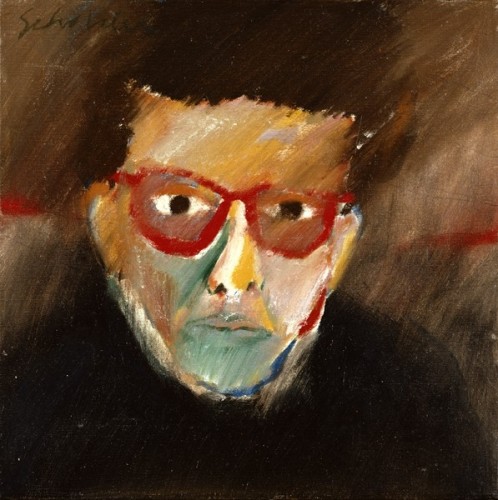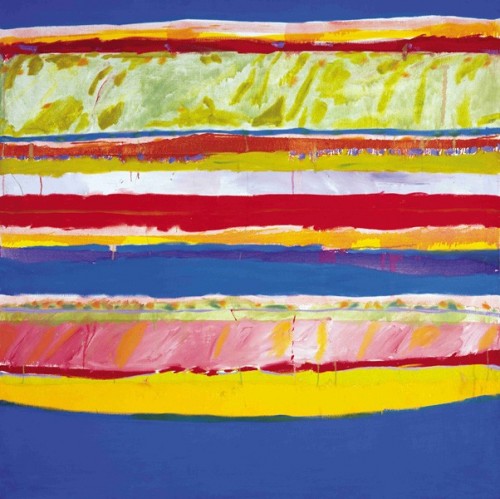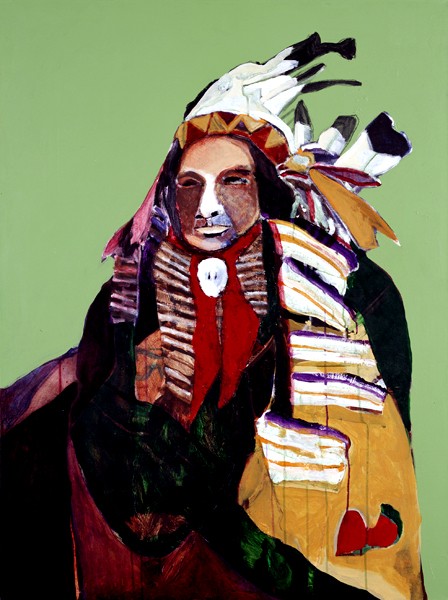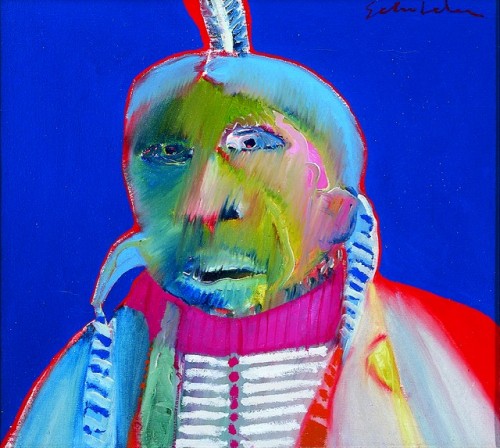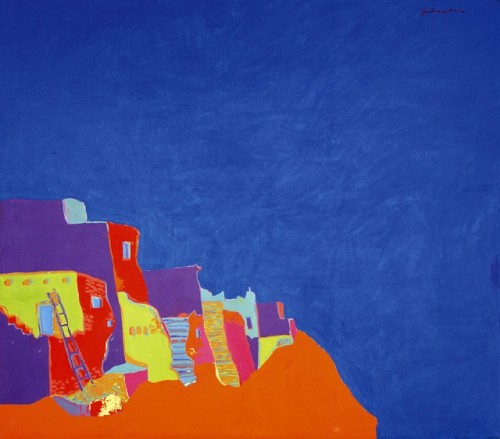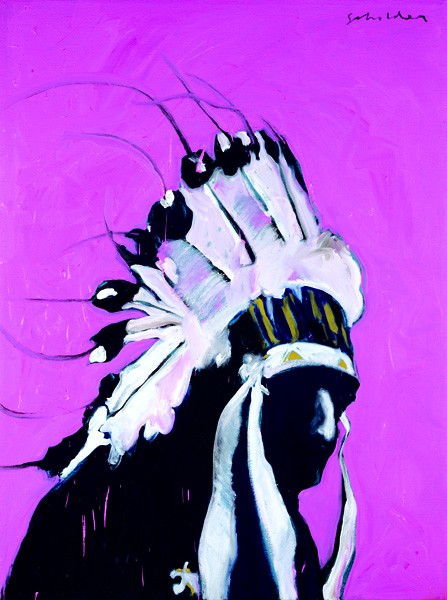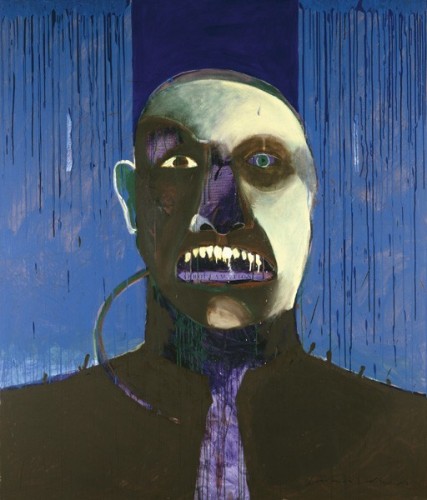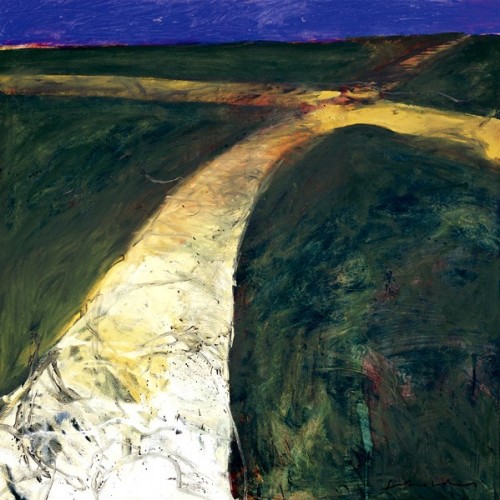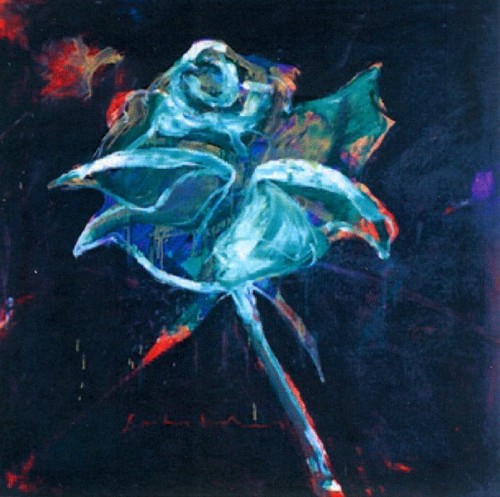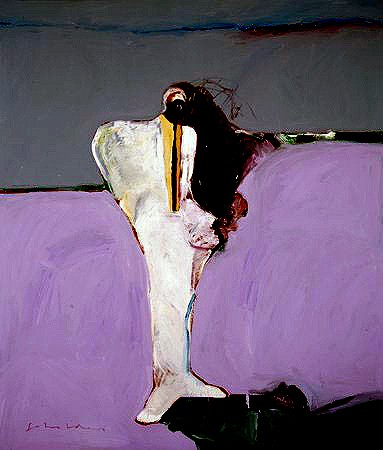Fritz Scholder: Indian/ not Indian
Retrospective Exhibitions in New York and Washington, D.C.
By: Charles Giuliano - Jan 01, 2009
Fritz Scholder: Indian/ not Indian
Curated by Truman T. Lowe and Paul Chaat Smith
Smithsonian's National Museum of the American Indian
NMAI on the National Mall
Fourth Street and Independence Avenue, S.W.
Washington D.C. 20560
Through August 16, 2009
http://www.nmai.si.edu
The George Gustav Heye Center
Alexander Hamilton U.S. Custom House
One Bowling Green
New York, New York, 10004
Through May 17, 2009
http://www.nmai.si.edu
Fritz Scholder: Indian/ not Indian
Edited by Lowery Stokes Sims with Truman T. Lowe and Paul Chaat Smith
Forward by Kevin Gover, Preface, John Haworth, Introduction, Lowery Stokes Sims, "Monster Love" Paul Chaat Smith "An American Expressionist" Leslie Wasserberger
"Schoelder's Figuration: Art and Culture in American Art" Lowery Stokes Sims
"The Institute of American Indian Arts and Contemporary Native Art" Richard W. Hill
"Schoelder's Legacy: A Roundtable Discussion" Moderated by Truman T. Lowe with Rick Bartow, Joanna Big-feather, Richard (Ric) Glazer-Danay, Jolene Rickard, Duane Slick, Alfred Young Man, W. Richard West
Published by Prestel, Munich, Berlin, London, New York, 192 pages, illustrated, with index, chronology, and notes on contributors, ISBN 978-3-7913-6158-1, $34.95, softbound.
Since its founding in 1989 by an Act of Congress the retrospective "Fritz Scholder: Indian/ not Indian," curated by Truman T. Lowe and Paul Chaat Smith, is the largest, most expensive and ambitious contemporary art project undertaken by the National Museum of the American Indian (NMAI). The scope of the overview of the controversial Scholder (1937-2005) is so expansive that it is being shown simultaneously in two parts both at NMAI in Washington, D.C. , through August 16, and at the NMAI's Smithsonian branch The George Gustav Heye Center in lower Manhattan, through May 17.
Emphasizing the significance and risk taking of this project Smith, during a telephone interview from D.C., stated that "An institution of our scale and budget can take on an exhibition like this only every five to ten years." The overview of the leading Native American artist of his generation became so enormous that a decision was reached to install the formative and most controversial "Indian" paintings and prints in some 8,000 square feet in Washington and the late period, of paintings and bronze sculptures, after Scholder had decided to abandon Indian subject matter (he would change his mind on that several times), in some 4,000 square feet in the New York venue. There are some late period Indian paintings but the curators opted to show then in D.C. and not New York.
In the catalogue essays about Scholder a word that crops up frequently, and the artist evoked to describe himself is "paradox." To which the response by Smith in the text is "no kidding." The layers of identity, iconoclasm, self promotion, gossip, controversy, love-hate, respect and dismissal are dense and daunting. It is surprising that the NMAI waded into this quagmire and then, more remarkably, opted to attack the paradox multi-valently "Indian/ not Indian" rather than gloss over or blow off the issues.
It was a risky decision that in many aspects underscores the mandate of the NMAI as an institution. There is an administrative relationship with the U. S. government which funds and supports the museums. Consider the complex and often horrendous policies of our government and its Bureau of Indian Affairs. A primary mission of the NMAI is to house and display historical artifacts and materials. It serves to educate a general public about Native culture. While there is that public outreach it is also a home and refuge to the legacy of Native Americans. Its exhibitions and policies are accountable to the diverse Native American community including both those living on and off the reservations; traditional and not. There are those who respect and follow traditions and ceremonies, as well as, many who ignore their Indian roots and have opted into the mainstream of American culture.
As an artist and individual Scholder found himself for better and worse at the very core of issues of identity and Native culture. Fritz Scholder IV was one quarter Luiseno (a California mission tribe). His father was half Indian, literally a "half breed" who worked as a school administrator and teacher for the Bureau of Indian Affairs. Like many of his generation he was not proud of his heritage. Fritz and his sister attended public schools and were forbidden to have contact with Indian children.
Scholder is quoted as recalling "We lived on the Indian school campus, because my father (who is half-Luiseno) worked for the Bureau of Indian Affairs. But we went to public schools. There were no Indian objects in the house. We never thought of ourselves as Indians. My father was a product of the old Indian schools-he was ashamed of being an IndianÂ…When my parents were married they were given beautiful Indian baskets, rugs and pottery, but in a couple of years my father threw them all away. I grew up with not one Indian object in the house, except for a pot my father gave me for my crayons." In an ironic twist that pot was made by the famous San Ildefonso Pueblo potter Maria Martinez.
Scholder was ambivalent about his Native identity but became rich and famous because of his deconstruction of its iconic imagery. When he was a celebrity living in Santa Fe, with other adobe homes in the South West, he surrounded himself with Native American artifacts including sacred objects that should not be owned by individuals. He became a world traveler with a special interest in the occult including Ancient Egypt and the Vampires of Transylvania. While he is best known and most popular for the some 300 Indian painting he created, he was also deeply influenced by a range of 19th and 20th century European masters from the Black Paintings of Goya, through Edvard Munch, and most importantly Francis Bacon.
Penetrating into the heart of darkness that was Fritz Scholder is somewhat like navigating into and out of the labyrinth at the center of which the artist was a minotaur. The artist was more than a bit of the monster so graphically depicted in the powerful and harrowing last works shown in New York. They are the anxious muted screams of a man weakened by diabetes who, like the deaf, late Goya, was struggling with the monsters of that sleep of impending death. One of the most poignant of these is "Self Portrait with Grey Cat" (2003) a dark, doomed self image seated in a chair with oxygen leaning on a cane with a book and black cat on the floor before him. It is a riveting, courageous and haunting image.
In the New York show we see works by an artist past the tipping point of celebrity. By then, perhaps, his star was in eclipse. The struggles of making it in the world of art and fashion were behind. One may argue that he was painting and sculpting to please himself. Like Goya making those horrifying, demonic works on the walls of his home in seclusion. Scholder is similarly described as withdrawn, secretive, controlling and paranoid. He was obsessed with the demons of the dark side. They haunt the epic scaled late paintings such as the nearly abstract gigantic heads that comprise the triptych "Heaven" "Hell" and "Purgatory." In other works he treated the themes of "Lilith No. 1" (1992) and variations on the traditional, medieval "Death and the Maiden" with a skeleton embracing an image of his wife. One feels the influence of Munch in "Vampire Kissing Fallen Angel No. 1" (1997) or the death grip embrace of "Dream No 1." (1981) and "Monster Love No 1" (1986)
The late work is so demonic and personal that it may be of little popular appeal and commercial value. Particularly as, by then, his career and reputation were in decline. When the art world stops paying attention there is liberation, and the resources in his case, to please yourself. It is a luxury and reward of age when warriors pull back from the fray and retreat into the inner sanctum of experience and memory. It is also the phase when artists may produce their most interesting but least accessible works. One thinks, for example, of Michalengelo's fragmented, ill proportioned, late mannerist Rondanini Pieta which he worked on during the last weeks before his death in 1564. Particularly when compared to the sanguine, gorgeous, youthful Vatican Pieta which first established his reputation as a master.
So just who is this artist presented by the NMAI? In a review in the Washington Post (Tuesday, December 9, 2008) titled "An Artist's Identity Theft' by Philip Kennicott he states that "It's hard not to walk through this exhibition and smell more than a whiff of fraud going on. It was a complicated fraud, though, maybe so complicated that the fraud itself approaches the level of art."
There has been little mainstream media attention, so far, given to this project. Because the exhibition will remain on view for several months Smith is confident there will be more coverage. Because the ambitious exhibition is so vital to NMAI, and the Native American community which it advocates, focusing on the theme of Scholder as "a fraud" particularly in the influential Washington Post, is hurtful and damaging. It has the impact of undermining and even dismissing a complex but ground breaking effort. What is at stake is mainstreaming Scholder and contemporary Native American Art to the front burner of the cultural hegemony. The notion of "fraud" confines the artist and his revolutionary art, a breakthrough for his generation and its cultural heritage, to the all too familiar back of the bus. During the height of his success and influence, as Smith discussed with me, Scholder was marginalized and dismissed as a provincial phenomenon, by art world insiders and critics.
Part of the issue is how Scholder managed his career and persona. He worked with many dealers but relatively few museum curators. As a result, evidenced by this catalogue, there is no impressive bibliography of scholarly articles. There were essays in several glossy monographs, and Scholder himself designed and published catalogues, posters and post cards, but his career, so far, has left relatively little in terms of a paper trail of dialogue and critical analysis. Even the catalogue which focuses on biography, source materials for the paintings, and an overview of his position in Native American and African American figuration, fails to include a single essay devoted to a formalist analysis and critical evaluation of the work itself. Smith indicates that efforts were made but potential writers were not available on the tight deadline to produce a catalogue.
One may speculate on the effectiveness of an exhibition with the theme of "Indian not Indian." It focuses on issues of identity rather than critical evaluation of the work which is the norm of a museum retrospective. This strategy contextualizes the artist and his issues but confines Scholder to a special interest niche. If this project were undertaken by a major museum it would likely have taken a different approach. The unfortunate conclusion is that a mainstream institution would not be likely to undertake a project on this scale. While Scholder was a star in the context of Native Art it is not entirely surprising that the Post dismisses him as "a fraud."
Scholder is way more complex and important than that. His conundrum resonates with many individuals who matured "off rez" only to struggle with their identity. The radical efforts of the Amerian Indian Movement (AIM) and other social agendas starting in the 1960s (which according to Smith it seems that Scholder abhorred) evoked pride in even the smallest slice of genetic heritage. But this has also intensified debate within the Native community about who is entitled to be an "enrolled Indian." Scholder was caught up in the maelstrom of identity politics as was Jimmie Durham, born 1940, who now lives in Europe, and a controversial young artist Brad Kahlheimer.
Until you get close to Native art and culture it is difficult to appreciate how vociferous and contentious are the debates centered on Indian not Indian. A good starting point is the 1969 book "Custer Died for Your Sins" by Vine Deloria, Jr. who died at 72 in 2005. His writing was witty and scorching; a must read for every informed American.
One chapter of the Scholder catalogue is a transcript of a roundtable discussion moderated by the curator, Truman T. Lowe. The intention was to assemble Native artists who knew him or were his students. They express strong opinions about his identity and legacy. It is some of the most riveting and insightful text in the book as an excerpt reveals.
Alfred Young Man: "Â…Years later I discovered that he was saying that he wasn't Indian after all- that he was, in fact, German. He clearly spells that out in a book I found called 'Sharing a Heritage.' So it confuses me why we are still extolling him as an Indian artist. Now either that's an identity crisis or it's something that his agents are promoting, which they often do in American society. This society exploits different people and situations- that's the name of the game. And to be a con man in this day and age is nothing new, and that's what's going on here."
Richard Glazer-Danay: "He wouldn't be a con man if he admitted what he was. All he said was Here's who I am, and Here's who I'm not."
Alfred Young Man: "He should have said that more forcefully and with a little more conviction and integrity. Our accepting him as everybody else accepted him, as a 'real Indian artist,' doesn't speak very well for Native history. It becomes problematic."
Rick Bartow: "I made a note that I received a letter from Fritz Scholder and some signed material on July 27, 1987. It said 'Dear Richard Bartow, Thank you for your kind letter; enclosed is a new catalogue.' But the reason I wrote to him was to say thank you for taking it in the neck as a mixed blood artist because early on they talked about how he was not a real Indian. This is ironic because the books or articles that I read discussed how he'd been maligned for painting the Gallup (New Mexico) streets, basically, and the Indians with cans of beer.
"My mother was white, my dad was Indian, and so I don't have trouble anymore with dual identity. Without either of those folks, I wouldn't be here. That some see the fact that he was mixed race as a problem is really kind of shocking to me"
"A fraud" in the Washington Post is one thing but to be labeled a "con artist" in the NMAI's own exhibition catalogue is even more remarkable. Where there's smoke there must be fire. So just what is the burning issue of the art and persona of Fritz Scholder that enflames Natives such as Alfred Young Man but evokes little beyond apathy in the mainstream art world and the media? Just how did Scholder come to touch on such a raw nerve?
Another way of stating the ideas of "fraud" or "con artist" is to acknowledge that Scholder represented a smoldering concoction of raw talent, driving ambition, savvy career moves, and a rock star's charisma. Add to that dollops of serendipitous opportunism Things fell into his lap and he was clever enough to run with them. One of the slurs on his reputation is that he stole and exploited the ideas of his students. True. But he had the ability to craft a career from this material while they did not. As Picasso stated "Minor artists borrow. Great artist steal." Scholder was a master thief and cultural criminal.
The turning point occurred in 1969 when he painted his most important single work, arguably, his masterpiece "Indian with Beer Can." The painting disappeared when it was sold. During the research for this exhibition it was tracked down to the collection of Ralph and Ricky Lauren. Through sensitive and complex negotiations (which Smith described) this key work was borrowed for the exhibition. By taking on the issues of alcoholism and Native American culture in such a bold and transgressive manner the work was offensive and insulting but also changed forever the perception and agenda for contemporary Native American Art.
Prior to that breakthrough in 1969 Native American Art was either embedded within traditions or catered to the romantic kitsch of the largely non Native market. It was light years away from the stylized illustrations of students of Dorothy Dunn at the Santa Fe Indian School's Art Studio (1937-1961).
While in secondary school his art teacher was the important Native painter Oscar Howe who studied in Europe and painted in a Cubist/ Native manner. At Sacramento City College Scholder studied with the figurative painter Wayne Thiebaud. Under a Rockefeller Foundation scholarship he was a part of the Southwest Indian Art Project at the University of Arizona. There he met the influential educator Lloyd Kiva New and studied with the Hopi artist and jeweler Charles Loloma. He began to exhibit and receive grants and prizes prior to graduation from a M.F.A. program at the University of Arizona.
As an enrolled Indian, in 1964, at the age of 27, he accepted a teaching position at the Institute of American Indian Arts in Santa Fe. There is a revealing photograph of Scholder at about this time posed like a young hipster in thick black glasses standing in front of his MG sports car. At an early age he was cognizant of his image. It makes an interesting comparison with another well crafted publicity shot of the artist at mid career standing in front of his Rolls Royce with an Afghan hound at his side and a tall cactus in the background. Scholder had a physical deformity of a hand and sloped shoulder which he was clever in concealing. It was yet another layer of his complex persona.
He arrived at the Institute as a young hotshot. Ironically, he advised students that they would never get anywhere making Indian art. Rather he exposed them to the abstract expressionism that influenced him and was bringing him some recognition and sales. His ambition was to be a player in the art world.
As a part of the resources of the Institute there was a trove of vintage photographs of Native Americans some of which were provided by the archives of the Smithsonian. These were primarily the iconic images of white photographers like Edward S. Curtis and A. C. Vroman. The students were appropriating these images in a fresh and irreverent manner. So much so that Richard W. Hill describes efforts by the Hopi elders to close the school or expel it from their property. Leslie Wasserberger expands on a master's thesis to discuss just what images were used and how they were cropped and changed. Scholder's seminal "Indian with Beer Can" from 1969 appears to be inspired by a remarkably similar image to "Indian Man" (1967) painted by his student T.C. Cannon (1946-1978). The pose and source may be identical but Scholder's painting pushed the envelope in an expressionist distortion of the face with snarling bared teeth, shades, and that all important addition of the powerful signifier, a can of Coors Beer. It stood the romantic notion of the Indian on its head by revealing through art the withering issue of alcoholism.
In a dramatic about face/ theft/ con/ fraud, Scholder, who denied being Indian, and told his Indian students that they would get nowhere painting Indian subjects, did just that. Having crossed the line he violated every possible taboo wrapping chiefs in American flags and depicting drunken Indians. He did so with a bravura style of painting with juicy medium and broad, sloppy, drippy brush strokes and strident pop colors. Broadening his reach and market he evolved as a master print maker. Even his exhibition posters and post cards were avidly collected. The work was outrageous, raw, strident and collectable. Consider, for example, works like a staggering drunken Indian in "Walking to the Next Bar" (1974) "Indian with Wine Bottle" (n.d.) or "Drunken Indian in Car" (1974). He also referenced the American Genocide with works such as "Massacre at Wounded Knee No.1" (1970), "Dying Indian" (1969), "Portrait of a Massacred Indian" (1972) "Dead Indians in a Wagon" (1970) and "After the Massacre" (1972).
While these powerful, lush and outrageous paintings and prints appealed to rich white collectors they were deeply offensive to many Native Americans. It is not surprising that while he enjoyed wealth and celebrity he also opted to spend more time abroad or to become increasingly reclusive. While he made some documentary films it appears that he was not receptive to the probing questions of critics and art historians.
Lowery Stokes Sims, currently curator at the Museum of Arts and Design in New York, and founding executive director of the Studio Museum in Harlem, served as editor of the Scholder catalogue. Her essay locates Scholder within the developments of figurative expressionism of his generation. She connects his approach with that of the Bay Area Figure painters and African American artists such as Hale Woodruff, Norman Lewis, Bob Thompson and Robert Colescott. She discusses the impact on Scholder's style by pop artists Larry Rivers and Andy Warhol. Sims also connects Scholder to leading Native artists of his generation Kay Walking Stick (Born 1935), Jaune Quick-to-See Smith (Born 1940), and younger artists James Luna (Born 1950) and Edgar Heap of Birds (Born 1954).
As a strategy Scholder denied that he was an Indian while also violating them. This was brutal and cruel or hilarious, fresh, and liberating. In one comical work "Super Indian No. 2" (1971), for example, he depicted an Indian in buffalo helmet taking a break from a ceremonial dance. In his hand instead of a rattle he holds a double scoop ice cream cone. While playful and even insulting it is also all too plausible and with glib legerdemain conflates traditional and contemporary culture.
Having danced on the graves of his ersatz heritage it is not surprising that the late works in the New York exhibition reveal him wrestling with demons. In that restive sleep at night no doubt he encountered many a Ghost Dancer, shade, and shadow catcher in the inevitable waltz to a turbulent grave. Arguably, his spirit does not rest in peace. Like Dr. Faust he may well have paid up to Mephistopheles. Buy now pay later. Hic transit Gloria mundi.

